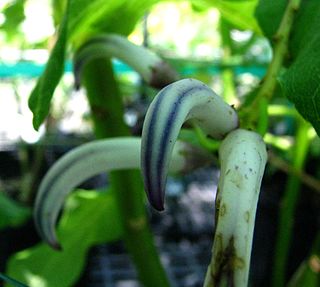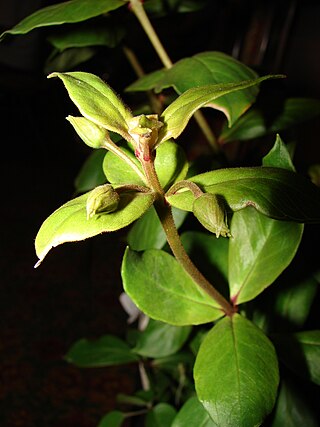
Mimallonidae (mimallonids), sometimes known as "sack-bearer" moths for the larval case-building behavior, are a family of Lepidoptera containing over 300 named species in 43 genera. These moths are found only in the New World, with most taxa occurring in the Neotropics. Adult moths are externally similar to those belonging to some of the other Macroheterocera families Bombycoidea and Drepanoidea, and thus have been variously treated as belonging to either one of these or other superfamilies.

Miconia crenata, commonly called soapbush, clidemia or Koster's curse, is a perennial shrub. It is an invasive plant species in many tropical regions of the world, causing serious damage.
The Clidemia thrips, Liothrips urichi, is a thrips species from Trinidad. It is used as a biological control agent to stop the spread of Clidemia hirta, an invasive plant species that does much damage in many tropical areas of the world.
100 of the World's Worst Invasive Alien Species is a list of invasive species compiled in 2000 from the Global Invasive Species Database, a database of invasive species around the world. The database is run by the Invasive Species Specialist Group (ISSG) of the International Union for Conservation of Nature (IUCN). The ISSG acknowledges that it is "very difficult to identify 100 invasive species from around the world that really are 'worse' than any others. ... Absence from the list does not imply that a species poses a lesser threat." In 2013, the ISSG updated their list to supersede the recently eradicated † rinderpest virus, and a few genus and species names were altered.
Antiblemma acclinalis is a moth of the family Noctuidae first described by Jacob Hübner in 1823. It is native to the Antilles. It was introduced in Hawaii to control Clidemia hirta. Although it has become established on Oahu, there is no indication that populations have persisted on Kauai or on Maui, where the moth was first released in 1996.

Darna pallivitta, the nettle caterpillar or stinging nettle caterpillar, is a moth of the genus Darna and family Limacodidae. It is native to China, Taiwan, Thailand, Peninsular Malaysia, Java and Borneo. It was introduced to Hawaii in 2001.
Carposina bullata is a moth of the Carposinidae family. It is native to Trinidad and Tobago, but has been introduced to Hawaii as biological control agent of the weed Clidemia hirta.

Ategumia ebulealis, the clidemia leafroller, is a moth of the family Crambidae. The species was described by Achille Guenée in 1854. It is found in Central America, the Antilles, and the south-eastern United States. It was thought to be introduced to Hawaii, but later research concluded it was actually Ategumia matutinalis which was released.
Ategumia matutinalis is a moth of the family Crambidae described by Achille Guenée in 1854. It is found in Central America, South America and the Antilles, including Puerto Rico, Trinidad, French Guiana, Suriname, Ecuador and Jamaica. It was introduced to Hawaii for the control of Clidemia hirta, although researchers thought they were introducing Ategumia ebulealis.
Druentica inscita is a moth of the family Mimallonidae. It is native to Mexico, and was thought to have been introduced to Hawaii for biological control of Clidemia hirta. However, recent research has suggested that the species introduced to Hawaii was misidentified, and is now known to be Druentica coralie.
Cyanea koolauensis is a rare species of flowering plant in the bellflower family known by the common names Palolo Valley rollandia and narrowleaf rollandia. It is native to Oahu, where it is known only from the Koʻolau Mountains. It is a federally listed endangered species. Like other Cyanea it is known as haha in Hawaiian.
Cyanea kuhihewa is a rare species of flowering plant in the bellflower family known by the common name Limahuli Valley cyanea. It is endemic to Kauai, where only two mature plants are known from a single wild population. Like other Cyanea it is known as haha in Hawaiian.
Cyrtandra subumbellata is a rare species of flowering plant in the African violet family known by the common name parasol cyrtandra. It is endemic to Hawaii, where it is known only from the Koʻolau Mountains on the island of Oahu. By 2008 there were three known populations containing 110 plants, or possibly more. It was federally listed as an endangered species in 1996. Like other Hawaiian Cyrtandra it is called ha`iwale.
Cyrtandra tintinnabula is a rare species of flowering plant in the African violet family known by the common name Laupahoehoe cyrtandra. It is endemic to the island of Hawaii, where it is known only from the slopes of Mauna Kea. As of 1996 there were only three occurrences containing fewer than 20 individuals total. It was federally listed as an endangered species in 1994. Like other Hawaiian Cyrtandra it is called ha`iwale.
Cyrtandra viridiflora is a rare species of flowering plant in the African violet family. It is endemic to Hawaii, where it is known only from the northern Koolau Mountains of Oahu. By 2003 there were nine small populations remaining, for a total of 69 plants. It was federally listed as an endangered species in 1996. Like other Hawaiian Cyrtandra it is called ha`iwale.

Cyanea rivularis is a rare species of flowering plant in the bellflower family known by the common name plateau cyanea. It is endemic to Hawaii, where it is known only from the island of Kauaʻi. There are three small populations of the plant remaining in the wild, for a total of 19 individual plants. The plant was federally listed as an endangered species of the United States in 1996.

Lysimachia remyi subsp. maxima is a rare species of flowering plant in the family Primulaceae known by the common name Pelekunu Trail yellow loosestrife. It is endemic to Hawaii, where there are only two small populations remaining on the island of Molokai. It is federally listed as an endangered species of the United States.
Melicope lydgatei is a rare species of flowering plant in the citrus family known by the common names Koolau Range melicope and Lydgate's pelea. It is endemic to Hawaii, where it is known only from the Koolau Range on the island of Oahu. It is a federally listed endangered species of the United States. Like other Hawaiian Melicope, this species is known as alani.
Trematolobelia singularis, the lavaslope false lobelia, is a rare species of flowering plant in the bellflower family. It is endemic to Hawaii, where it is known only from the Koʻolau Range on the island of Oahu. It is threatened by the degradation of its habitat. It is a federally listed endangered species of the United States.
Compsolechia seductella is a moth of the family Gelechiidae. It was described by Francis Walker in 1864. It is found in Amazonas, Brazil.






